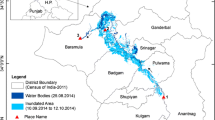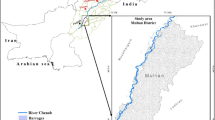Abstract
Flash floods are among the most common natural hazards in Egypt. Wadi El-Darb, one of the vastest drainage catchment in the Eastern Desert of Egypt, is considerably subjected to severe flash flood events. The coastal city of Ras Gharib is located at the outlet of this Wadi, which consequently makes it susceptible to the flash flood hazard. Ras Gharib has a strategic importance to Egypt that it produces 65% of the petroleum requirement; therefore, the government seeks hard to protect the city. Using hydrological modeling approach was necessary, especially in case of the lack of hydrological and meteorological data in the region, to simulate the spatial extent, depth, and speed of the floodwater and then identify the sites at risk of flooding. The elevation data were extracted from digital elevation models (SRTM and ALOS PALSAR). The soil texture properties can be derived from Sentinel-1 radar images fused with geological data to produce the hybrid land cover map containing the rock types and their texture information. Sentinel-2 imagery was used to map the land use/land cover (LULC) in the downstream area of the basin. The results showed that the rainstorm with 51 mm of precipitation intensity would cause, at the outlet of the Wadi El-Darb basin, peak discharge rate of 852.73 m3/s, and the flash flood water can reach Ras Gharib city within 4 h, with an average flood depth of 1.69 m. Also, the flash flood impacts concentrated in the midtown covering about 2.93 km2, about 342 houses, 33.35 km of Ras Ghareb-Minya highway, and 55.9-km long of the internal road network were inundated. The hydrologic modeling results were validated using Jaccard coefficient (= 0.72), based on the integration of Sentinel-2 images along with aerial photos (captured post the flood), Google Earth images, and Open Street Map (OSM). Accordingly, this work provides the developing countries with a practical and quick technique to predict flash flood hazards in arid regions where data are scarce.












Similar content being viewed by others
References
Abdalla F, El Shamy I, Bamousa AO, Mansour A, Mohamed A, Tahoon M (2014) Flash floods and groundwater recharge potentials in arid land alluvial basins, southern Red Sea coast, Egypt. International Journal of Geosciences 05:971–982. https://doi.org/10.4236/ijg.2014.59083
Abdelbasset M, Abderrahim L, Ali CA, Abdellah B, Lahcen B, Laila B (2015) Integration of GIS and HEC-RAS 2D in floods modeling of the Ouergha river. Northern Morocco, European Scientific Journal http://eujournal.org/index.php/esj/article/view/4969
Abdelkarim A, Gaber AF (2019) Flood risk assessment of the Wadi Nu’man Basin, Mecca, Saudi Arabia (during the period, 1988–2019) based on the integration of geomatics and hydraulic modeling: a case study. Water 11. https://doi.org/10.3390/w11091887
Abdelkarim A, Al-Alola SS, Alogayell HM, Mohamed SA, Alkadi II, Youssef IY (2020) Mapping of GIS-flood hazard using the geomorphometric-hazard model: case study of the al-shamal train pathway in the city of Qurayyat, Kingdom of Saudi Arabia. Geosciences 10(9):333
Almouctar MAS, Wu Y, Kumar A, Zhao F, Mambu KJ, Sadek M (2021) Spatiotemporal analysis of vegetation cover changes around surface water based on NDVI: a case study in Korama basin, Southern Zinder, Niger. Applied Water Science 11(1):1–14
Aryal, D., Wang, L., Adhikari, T. R., Zhou, J., Li, X., Shrestha, M., ... & Chen, D. (2020). A model-based flood hazard mapping on the southern slope of Himalaya. Water, 12(2), 540.
Bahrawi J, Ewea H, Kamis A, Elhag M (2020) Potential flood risk due to urbanization expansion in arid environments, Saudi Arabia. Natural Hazards 104(1):795–809
Baky MAA, Islam M, Paul S (2020) Flood hazard, vulnerability and risk assessment for different land use classes using a flow model. Earth Systems and Environment. Springer International Publishing 4(1):225–244. https://doi.org/10.1007/s41748-019-00141-w
Bioresita F, Puissant A, Stumpf A, Malet JP (2018) A method for automatic and rapid mapping of water surfaces from sentinel-1 imagery. Remote Sensing 10. https://doi.org/10.3390/rs10020217
Çelik HE, Kurdoğlu O, İnan M, Kadıoğlu M, Nişancı İ (2020) Identifying causes of the 2015 Hopa flash flood in NE Turkey and mitigation strategies. Environmental Monitoring and Assessment 192(12):1–15
Clement MA, Kilsby CG, Moore P (2018) Multi-temporal synthetic aperture radar flood mapping using change detection. Journal of Flood Risk Management 11(2):152–168
Congalton RG (1991) A review of assessing the accuracy of classifications of remotely sensed data. Remote Sensing of Environment 37:35–46. https://doi.org/10.1016/0034-4257(91)90048-B
Cools, J., Vanderkimpen, P., El Afandi, G., Abdelkhalek, A., Fockedey, S., El Sammany, M., ... & Huygens, M. (2012). An early warning system for flash floods in hyper-arid Egypt. Natural Hazards and Earth System Sciences, 12(2), 443-457.
Costabile P, Costanzo C, Ferraro D, Macchione F, Petaccia G (2020) Performances of the new HEC-RAS version 5 for 2-D hydrodynamic-based rainfall-runoff simulations at basin scale: comparison with a state-of-the art model. Water 12(9):2326
Cronshey, R. (1986). Urban hydrology for small watersheds. US Dept. of Agriculture, Soil Conservation Service, Engineering Division.
Dossou JF, Li XX, Sadek M, Almouctar MAS, Mostafa E (2021) Hybrid model for ecological vulnerability assessment in Benin. Scientific Reports 11(1):1–15
Feldman, A. D. (2000). Hydrologic modeling system HEC-HMS: technical reference manual. US Army Corps of Engineers, Hydrologic Engineering Center.
Gascon F, Bouzinac C, Thépaut O, Jung M, Francesconi B, Louis J, Languille F (2017) Copernicus Sentinel-2A calibration and products validation status. Remote Sensing 9. https://doi.org/10.3390/rs9060584
Geriesh, M. H., El-Rayes, A. E., & Fouad, A. (2004). Runoff control and management in Wadi Ghweiba hydrographic basin, northwest of Gulf of Suez region, Egypt. In Proceedings of 7th conference on Geology of Sinai for Development, Ismailia (pp. 53-67).
Hammond MJ, Chen AS, Djordjević S, Butler D, Mark O (2015) Urban flood impact assessment: a state-of-the-art review. Urban Water Journal 12:14–29. https://doi.org/10.1080/1573062X.2013.857421
HEC–GeoRAS, G. I. S. (2011). Tools for support of HEC-RAS 2D using ArcGIS user’s manual, version 4.3. 93. US Army Corps of Engineers, Institute for Water Resources Hydrologic Engineering Center.
Hermas, E., Gaber, A., & El Bastawesy, M. (2020). Application of remote sensing and GIS for assessing and proposing mitigation measures in flood-affected urban areas, Egypt. The Egyptian Journal of Remote Sensing and Space Science.
Hu Q, Wu W, Xia T, Yu Q, Yang P, Li Z, Song Q (2013) Exploring the use of Google Earth imagery and object-based methods in land use/cover mapping. Remote Sensing 5(11):6026–6042
Jothimani M, Dawit Z, Mulualem W (2020) Flood susceptibility modeling of Megech River Catchment, Lake Tana Basin, North Western Ethiopia, using morphometric analysis. Earth Systems and Environment. Springer International Publishing 5:353–364. https://doi.org/10.1007/s41748-020-00173-7
Manawi SMA, Nasir KAM, Shiru MS, Hotaki SF, Sediqi MN (2020) Urban flooding in the Northern Part of Kabul City: causes and mitigation. Earth Systems and Environment. Springer International Publishing. 4:599–610. https://doi.org/10.1007/s41748-020-00165-7
Mashaly J, Ghoneim E (2018) Flash flood hazard using optical, radar, and stereo-pair derived dem: Eastern desert, Egypt. Remote Sensing 10. https://doi.org/10.3390/rs10081204
Mustafa EK, Co Y, Liu G, Kaloop MR, Beshr AA, Zarzoura F, Sadek M (2020) Study for predicting land surface temperature (LST) using Landsat data: a comparison of four algorithms. Advances in Civil Engineering 2020:1–16
Natarajan S, Radhakrishnan N (2020) Flood hazard delineation in an ungauged catchment by coupling hydrologic and hydraulic models with geospatial techniques—a case study of Koraiyar basin, Tiruchirappalli City, Tamil Nadu, India. Environmental Monitoring and Assessment 192(11):1–26
Negm, A. M., & Omran, E. S. E. (2020). Introduction to “flash floods in Egypt”. In Flash Floods in Egypt (pp. 3-9). Springer, Cham.
Notti D, Giordan D, Caló F, Pepe A, Zucca F, Galve JP (2018) Potential and limitations of open satellite data for flood mapping. Remote sensing 10(11):1673
Ottinger M, Clauss K, Kuenzer C (2017) Large-scale assessment of coastal aquaculture ponds with Sentinel-1 time series data. Remote Sensing 9(5):440
Prama M, Omran A, Schröder D, Abouelmagd A (2020) Vulnerability assessment of flash floods in Wadi Dahab Basin, Egypt. Environmental Earth Sciences 79(5):1–17
Rahman MS, Di L (2017) The state of the art of spaceborne remote sensing in flood management. Natural Hazards 85(2):1223–1248
Saber M, Kantoush S, Abdel-fattah M, Sumi T (2017) Assessing flash floods prone regions at wadi basins in Aswan, Egypt. B= Disaster Prevention Research Institute Annuals. B 60(B):853–863
Saber M, Abdrabo KI, Habiba OM, Kantosh SA, Sumi T (2020) Impacts of triple factors on flash flood vulnerability in Egypt: urban growth, extreme climate, and mismanagement. Geosciences 10(1):24
Sadek M, Li X (2019) Low-cost solution for assessment of urban flash flood impacts using Sentinel-2 satellite images and fuzzy analytic hierarchy process: a case study of Ras Ghareb City, Egypt. Advances in Civil Engineering 2019:1–15. https://doi.org/10.1155/2019/2561215
Sadek, M., Li, X., Mostafa, E., Freeshah, M., Kamal, A., Adou Sidi Almouctar, M., Zhao, F., Mustafa, EL. (2020). Low-cost solutions for assessment of flash flood impacts using Sentinel-1/2 data fusion and hydrologic/hydraulic modeling: Wadi El-Natrun region, Egypt. Advances in Civil Engineering.
SCS, U. (1985). National engineering handbook, section 4: hydrology. US Soil Conservation Service, USDA, Washington, DC.
Shawky M, Moussa A, Hassan QK, El-Sheimy N (2019) Pixel-based geometric assessment of channel networks/orders derived from global spaceborne digital elevation models. Remote Sensing 11(3):235. https://doi.org/10.3390/rs11030235
Sosnowski A, Ghoneim E, Burke JJ, Hines E, Halls J (2016) Remote regions, remote data: a spatial investigation of precipitation, dynamic land covers, and conflict in the Sudd wetland of South Sudan. Applied Geography 69:51–64
Thirumurugan P, Krishnaveni M (2019) Flood hazard mapping using geospatial techniques and satellite images—a case study of coastal district of Tamil Nadu. Environmental monitoring and assessment 191(3):193
Tirkey AS, Pandey AC, Nathawat MS (2014) Use of high-resolution satellite data, GIS and NRCS-CN technique for the estimation of rainfall-induced run-off in small catchment of Jharkhand India. Geocarto International 29(7):778–791
Acknowledgements
The authors would like to thank European Commission’s Copernicus program to support free data Sentinel-1 and 2 and the Egyptian Water Resource Institute for providing the essential information about flash flood in Ras Ghareb city.
Author information
Authors and Affiliations
Contributions
M.S, X.L, and E.M have contributed in conceptualization, methodology, validation, investigation, and writing-original draft preparation. Furthermore, J.D has contributed in review project administration, writing-original draft preparation, and writing-review and editing.
Corresponding author
Ethics declarations
Conflict of interest
The authors declare no competing interests.
Additional information
Responsible Editor: Amjad Kallel
Supplementary Information
ESM 1
(1) band combinations, (2) data availability, (3) videos and links, (4) outputs of HEC-RAS 2D software, (5) outputs of WMS software, and (6) photos after flood (DOCX 8614 kb)
Appendix
Appendix
The used equations for computing the hydrological parameters
Equation | Parameters |
Sr = 25.4((1000/CN) − 10) | Sr = maximum potential retention (mm) CN= curve number Q = depth of direct runoff (mm) P = depth of precipitation (mm) Tc = time of concentration (min) L = maximum flow distance (m) S = maximum flow distance slope (%) TLAG = lag time (hour) qp = peak discharge (m3/s) A = drainage area (km2) Tp = time until the peak (hour) Δt = duration of designed stormwater |
\( \mathbf{Q}=\frac{{\left(\mathbf{P}-\mathbf{0.2}\mathbf{Sr}\right)}^{\mathbf{2}}}{\left(\mathbf{P}+\mathbf{0.8}\mathbf{Sr}\right)} \) | |
\( {\mathbf{T}}_{\boldsymbol{c}}=\mathbf{0.0195}\ \left(\ \frac{{\boldsymbol{L}}^{\mathbf{0.77}}}{{\boldsymbol{S}}^{\mathbf{0.385}}}\right) \) | |
TLAG = 0.6 × Tc | |
\( \mathbf{qp}=\frac{\mathbf{0.208}\ \mathbf{AQ}}{\kern1em {\mathbf{T}}_{\mathbf{P}}} \) | |
TP = ∆t/2 + TLAG |
Rights and permissions
About this article
Cite this article
Sadek, M., Li, X., Mostafa, E. et al. Monitoring flash flood hazard using modeling-based techniques and multi-source remotely sensed data: the case study of Ras Ghareb City, Egypt. Arab J Geosci 14, 2030 (2021). https://doi.org/10.1007/s12517-021-08341-3
Received:
Accepted:
Published:
DOI: https://doi.org/10.1007/s12517-021-08341-3




